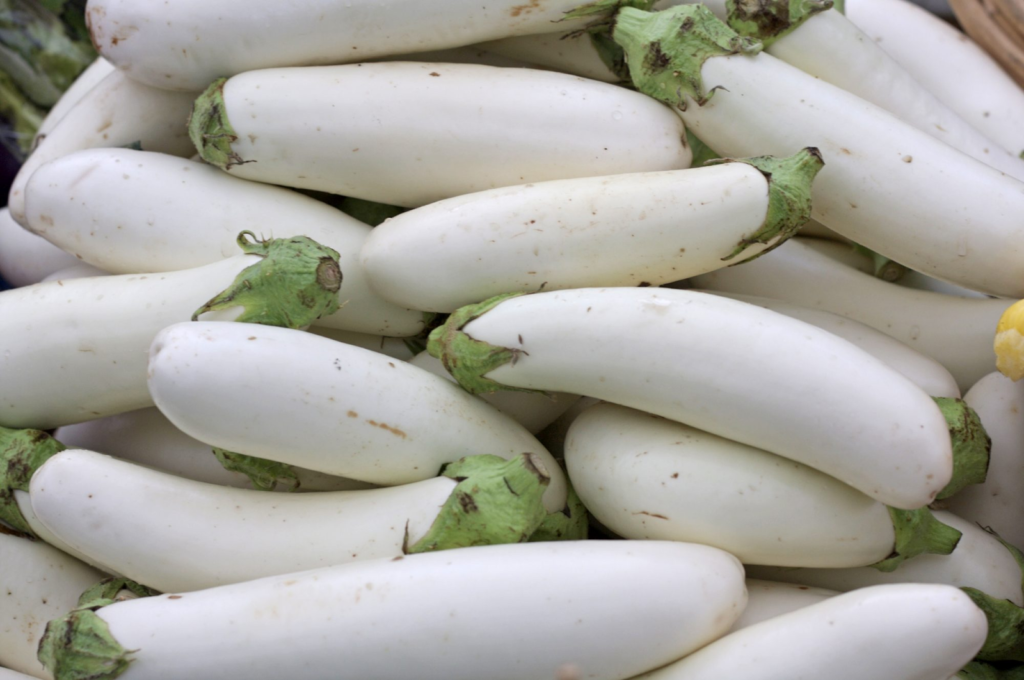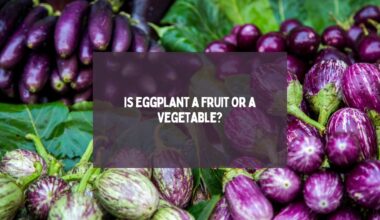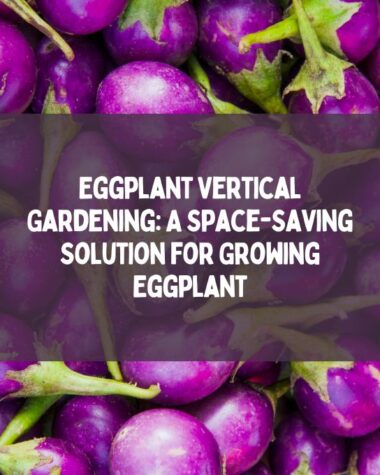White eggplants, which have stunning skin and mild, creamy flesh, are a delightful addition to the world of vegetables. These elegant and unique eggplants offer a fresh twist on the more common purple varieties.
Their smooth texture and subtle flavor make them a versatile ingredient in various culinary dishes. Whether roasted, grilled, stuffed, or pureed, white eggplants add a touch to dishes for both the eyes and the taste buds.
White eggplants also provide nutritional benefits, including dietary fiber and essential vitamins.
In this article, I will explore the versatility of white eggplant.
Let’s Start.
Introducing The Beautiful White Eggplant

Growing white eggplant varieties adds a great touch to your garden.
Here’s a brief history of white eggplant presented in table format:
| Aspect | Details |
| Plant Type | Open-pollinated |
| Harvest Time | Around 70-90 days after planting |
| Season | Warm season crop |
| Plant Height | Typically 2-3 feet (60-90 cm) tall |
| Timing | Start seeds indoors 8-10 weeks before last frost date |
| Common Pests | Aphids, flea beetles, spider mites |
| Germination | Soil temperature: 75-85°F (24-29°C) |
| Requirements | Moist soil and consistent watering |
| Seed Depth | ¼ inch (6 mm) |
| Spacing | 18-24 inches (45-60 cm) apart |
| Family | Solanaceae |
| Botanical Name | Solanum melongena |
It’s always recommended to refer to seed packets or consult local gardening resources for more detailed and precise information on specific white eggplant varieties.
Read on to learn more about the white shades of eggplant.
Related Reading
- Is Eggplant a Fruit or a Vegetable?
- Guide On Eggplant Life Cycle: From Seed Germination To Harvesting And Storing
- Where Do Aubergines Grow Naturally?
- Eggplant Water Requirements: How Much Water Do Eggplants Need?
Nutritional Benefits Of White Eggplant
White eggplant is a nutritious vegetable that also offers several benefits. Here are some of its nutritional benefits:
1. Low in Calories
White eggplant is a low-calorie vegetable, making it a great choice for those watching their calorie intake. It contains approximately 20 calories per 100 grams, making it a suitable option for weight management.
2. Low in Fat
White eggplant is naturally low in fat. It contains minimal amounts of saturated and trans fats.
3. Good Source of Fiber
White eggplant is a good source of dietary fiber, which is beneficial for digestive health. Fiber helps promote regular bowel movements, aids in maintaining a healthy weight, and supports heart health.
4. Rich in Antioxidants
White eggplant, like other eggplant varieties, contains antioxidants such as anthocyanins, chlorogenic acid, and flavonoids. These antioxidants help protect the body against oxidative stress and reduce the risk of chronic diseases.
5. Vitamins and Minerals
White eggplant is a good source of various vitamins and minerals, including vitamin C, vitamin K, vitamin B6, folate, potassium, and manganese. These nutrients play important roles in maintaining overall health, supporting immune function, promoting bone health, and regulating blood pressure.
6. Hydration
White eggplant has a high water content, contributing to hydration when consumed. Staying hydrated is essential for numerous body functions.
White eggplant depends on factors such as the specific variety, growing conditions, and preparation methods. To maximize the nutritional benefits, consider cooking white eggplant with minimal added fat.
How To Grow White Eggplant From Seeds?

Growing white eggplant from seeds is a rewarding experience that allows you to enjoy the fresh produce right from your garden.
Here’s a step-by-step guide on how to grow white eggplant from seeds:
1. Selecting White Eggplant Seeds
Choose high-quality white eggplant seeds from the garden center. Look for varieties specifically labeled as white eggplants.
2. Starting Indoors
Start the seeds indoors about 8 to 10 weeks before the last expected frost date in your area. Fill seed trays or pots with a well-draining seed-starting mix.
3. Sowing the Seeds
Plant the white eggplant seeds about 14 inches deep in the soil. Space them approximately 2 inches apart. Lightly water the soil to ensure it’s evenly moist.
4. Providing Ideal Growing Conditions
Place the seed trays or pots in a warm location, ideally between 75°F and 85°F. You can use a seedling heat mat to maintain the desired temperature.
5. Ensuring Adequate Light
Once the seedlings emerge, provide them with light. Place them in a sunny window or under grow lights. Aim for 14 to 16 hours of light per day.
6. Watering and Feeding White Eggplants
Keep the soil moist but not waterlogged. Water the seedlings whenever the top inch (2.5 cm) of soil feels dry. Fertilize them every two weeks with a balanced liquid fertilizer.
7. Transplanting Outdoors
When the seedlings have grown to around 6 to 8 inches tall, they are ready to be transplanted outdoors. Before transplanting, gradually expose the seedlings to outdoor conditions over the course of a week. Start by placing them outdoors in a sheltered spot for a few hours, and gradually increase the time and exposure to direct sunlight.
8. Watering and Mulching
Water the newly transplanted seedlings thoroughly and add a layer of organic mulch around the plants to help retain moisture and suppress weeds.
9. Providing Support
As the white eggplants grow, they may require support to prevent the stems from bending or breaking. Place stakes or cages near the plants to support them as they grow taller.
10. Harvesting White Eggplants
White eggplants are typically ready for harvest around 70 to 90 days after planting, depending on the variety. Harvest the eggplants when they have reached a mature size, are firm, and have a glossy white color.
When And How To Pick White Eggplants?

Knowing when and how to pick white eggplants is crucial to ensuring they are at their peak flavor and texture.
- White eggplants are typically harvested when they reach a mature size but are still firm and glossy. The exact size may vary depending on the specific variety, but they are usually around 6 to 8 inches in length. The color should be a uniform, creamy white without any signs of discoloration or blemishes.
- Gently press your finger against the skin of the eggplant. A ripe white eggplant should feel firm but not too hard.
- Examine the stem of the eggplant. It should be green and intact. A dried or withered stem indicates an older eggplant that may not be as fresh.
- White eggplants are typically ready for harvest around 70 to 90 days after planting.
- To harvest a white eggplant, use a sharp knife or pruning shears to cut the fruit from the stem, leaving a small portion of the stem attached. Avoid pulling or twisting the eggplant, as this can damage the plant.
- Regularly check your white eggplant plants for ripe fruits. Harvesting the eggplants frequently encourages the plant to produce more. Aim to harvest them when they are still young and tender for the best flavor and texture.
Culinary Uses Of White Eggplant
White eggplant, with its mild flavor and tender texture, offers a range of culinary uses that can be used in unique and delicious dishes.
Here are some popular culinary uses of white eggplant:
- Grilled or Roasted: White eggplant is fantastic when grilled or roasted. Its creamy flesh becomes soft and tender, with a slightly smoky flavor. It can be seasoned with herbs, olive oil, and spices to enhance its taste.
- Stuffed: White eggplant’s hollow shape makes it ideal for stuffing. Cut the eggplant in half, scoop out the flesh, and fill it with a flavorful mixture such as rice, breadcrumbs, herbs, cheese, or ground meat.
- Pureed: White eggplant can be cooked and pureed into a smooth consistency, making it a wonderful base for dips, spreads, and sauces. Combine it with ingredients like garlic, tahini, lemon juice, and olive oil to create a creamy and flavorful dip.
- Stir-Fried or Sautéed: White eggplant can be sliced or cubed and quickly stir-fried or sautéed with other vegetables, herbs, and spices. Its mild flavor allows it to absorb the flavors of the other ingredients while retaining its own unique taste.
- Pickled or preserved: White eggplant can be pickled or preserved to extend its shelf life and enhance its flavor. It can be pickled in vinegar or brine, providing a tangy and savory addition to sandwiches, salads, or platters.
- Tempura or Fritters: White eggplant slices or cubes can be dipped in a light batter and fried until crispy, resulting in delectable tempura or fritters. With dipping sauces on the side, serve them as snacks or appetizers.
These are just a few examples of the culinary uses of white eggplant. Its versatility allows it to be incorporated into various dishes, from appetizers to main courses.
Related Reading
- How To Grow Pumpkins in Raised Beds?
- Can You Eat Deformed Zucchini?
- Tomato Plant Care: A Brief Guide to Growing and Nurturing Healthy Tomatoes
- What Is the Best Time to Plant Carrots?
Conclusion
White eggplants stand out as a unique vegetable that offers a delightful culinary experience. With their beautiful skin, mild flavor, and tender texture, they bring a touch of elegance to any dish.
These are used in traditional recipes, and their versatility allows for a wide range of cooking methods, from grilling to stuffing. White eggplants also provide nutritional benefits, making them a healthy addition to any diet.
Thanks for reading!







